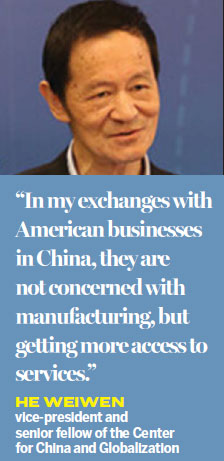Gearing up

He, a former economic and commercial counselor at the Chinese Consulate General in New York and San Francisco, believes it will be a challenge to get US companies to invest more in Chinese manufacturing.
"In my exchanges with American businesses in China, they are not concerned with manufacturing, but getting more access to services, not only financial services like banking and insurance but also legal consulting, leisure and medical services."
Williamson at Cambridge, who was speaking from Switzerland after attending the Davos forum, says the problem with some of the current debate is that it is couched in terms of manufacturing still being vertically integrated and companies doing everything in one location.
He says that model began to die out in the 1990s - driven to a large degree by China - and now the whole production system is built on global supply chains.
"When Donald Trump talks about bringing manufacturing back, what exactly is he talking about? The real question is what bits of this complex global supply chain can be moved and the economics are going to be different depending on which part of the chain you are taking about because some bits are capital-intensive and some labor-intensive."
"It would be quite some paradox if the bit that gets moved back to the US is the final assembly operation."
Fuyao was not the first Chinese manufacturer to set up a production facility in the US.
Wanxiang Group, based in Hangzhou, has made a series of acquisitions in the US, including buying bankrupt A123 Systems, a battery maker, for $256 million.
Edward Tse, chairman and founder of Gao Feng Advisory, the management consultancy, says a pattern is emerging of Chinese companies doing relatively low-end manufacturing in the US and buying up high-end facilities in Europe.
"We have had a lot of clients come to us looking to make acquisitions in the US, particularly in automotive parts, consumer retail and areas like building materials," he says.
"When it comes to areas like high-end manufacturing, they are looking to make acquisitions in Germany, the UK and places like Switzerland and Austria."
Tse, author of The China Strategy, says this separation has emerged mainly because of US resistance to Chinese technology companies like telecommunications giant Huawei making investments in the US.
"What you are seeing instead is Chinese money in start-up investments in Silicon Valley, Seattle and on the east coast around Boston and Cambridge. They are often part American and part Chinese ventures and because they are small, they are subject to much less scrutiny."
Jeffrey Towson, professor of investment at Peking University's Guanghua School of Management, says even if there is a major wave of Chinese manufacturing investments in the Rust Belt or major reshoring by US companies, it is unlikely to create the jobs that Trump craves.
"The biggest impact on manufacturing jobs in the US has not been offshoring to Asia or China but the advance of technology," he says.
"It is wiping out jobs far faster than offshoring ever did. It is going to be an increasing phenomenon and is not a trend that will reverse itself."
Thun at Said Business School believes China is following the right strategy in trying to upgrade its manufacturing by partnering with foreign firms.
"This has so far involved acquiring German firms. There is some concern in Germany about losing their crown jewels, particularly the family-owned mittelstadt (small to medium-sized) companies which are often willing to sell out."
"For China to be successful in high-end manufacturing, they need to acquire some of these German institutional and educational structures that promote this type of precision engineering. If you can't beat them at their own game, you can always acquire them," he says.
andrewmoody@chinadaily.com.cn













